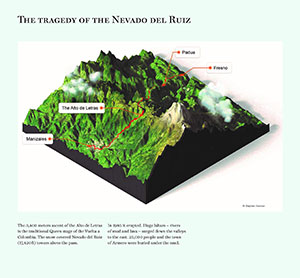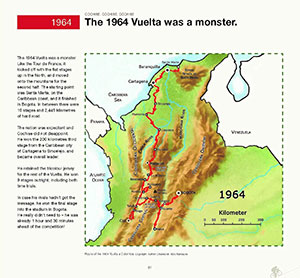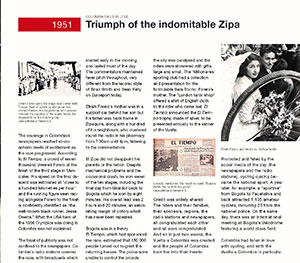
..........................................................................................................................................................................................................
the big climb. how the world's toughest road race created a nation of cycling superstars. stephen norman. smiths hall publishing softback. 173pp illus. £22.50

it's not so very long ago that britain was considered something of a backwater in velocipedinal terms. yes, there was tom simpson, brian robinson, iain steel and robert millar occasionally flying the flag, but that was over a substantial time-frame, and not one that would point to the emergence of our nation as a force to be reckoned with. central europe had, until relatively recently, been seen as the traditional hotbed of cycling champions: fausto coppi, eddy merckx, bernard hinault, jacques anquetil et al. even the americans, despite a considerable population upon which to draw, excluding the excluded armstrong years, have fared little better than the uk.

in short, it may be a tad myopic to think of cycling victories in nationalistic terms. strong individual riders, it seems, who happen to find themselves in the right team, are more than likely to find victory. would formula one's lewis hamilton be fêted quite as much, were he to have languished in one of the sport's less well-funded cars?
of course, britain's success has taken a distinct upward turn since the advent of lottery funding, initially on the track, but subsequently also in the grand tours. with geraint thomas's second place in last year's tour de france, it would be foolish to predict that success from this side of the channel is about to wane. but if we take note of the ineos rider who finished ahead of thomas, perhaps it wouldn't be outlandish to take note of the recent emergence of cycling talent from colombia.

this is the contention of author stephen norman, who has written a well-researched book on the rise and rise of colombian cycling, paving the way for the successes of egan bernal, nairo quintana, esteban chaves (who has written the foreword), rigoberto úran and others. researching for a novel to be set within the confines of a grand tour, norman was apparently struck by the successes of the colombian riders and wondered why these should be particular to this one country, rather than any of the neighbouring nations. it transpired that colombian cyclists were outperforming the rest of south america combined. what could be their secret?
his continued research led to the revelation that there was precious little in print regarding colombia's indigenous velocipedinal life (before you rush to point it out, he does give credence in the footnotes, to matt rendell's excellent 'kings of the mountains') according to the author, it is particularly informative to return to the early 1950s and the instigation of the tour of colombia, when 35 intrepid riders assembled in bogota to ride across the mountains on roads more suited to the current trend for gravel bikes. you need only pay heed to the illustration atop this review, to see how true that was.

but what of those mountains? how many of us have the faintest idea of what he speaks? in fact, if only to confirm the author's discovery that colombia itself is hardly well-documented, other than by its reputation for constant drug wars and shootings, who amongst us knows much, if anything, about the country? thankfully, stephen norman has had the perspicacity to place all this in some form of geographical, sociological and political context. for instance, the country is comprised of 32 departments, or states, each of which has a capital, an assembly and its own governor. the topography of colombia has combined to provide each of these departments its own cultural identity.

there are three 'fingers of mountain ranges stretching from colombia's southern border to its north eastern meeting with venezuela. the capital, bogota, sits on the eastern cordilleras, a mountain range with permanently snow-covered peaks rising to 5,000 metres. nairo quintana, raised in a farmhouse in boyaca (3,200 metres) was in the habit of riding 16 kilometres to school, with an ascent on the return trip of over 700 metres. how many of our sunday morning rides feature that before coffee?
the mainstay of the big climb is a year by year reprise of the tour of colombia, commencing in 1950, regularly punctuated with more specific, but related digressions:
"Colombian cyclists are popularly known as 'escarabajos'. An escarabajo - a scarab - is a species of beetle, common in Colombia.
"It was Ramón Hoyos was first called 'un escarabajo', after his spectacular performance climbing the Alto de Latras in the 1952 Vuelta (de Colombia)"

the book is also illustrated beyond your wildest dreams. in fact, if the book has one major strength, it is in the iconic, monochrome photography, a feature that doubtless took many rigorous hours of research to unveil. in fact, there is a double-page-spread displaying the work of horacio gil ochoa, who spent almost 40 years photographing bike racing, mostly in south america and, not unnaturally, including the tour of colombia.
south americans have a reputation for being hot-blooded, prone to spontaneous celebration and an enthusiastic support of their heroes. you need only recall the virtual deification of brazilian formula one driver, ayrton senna. and it appears that the colombians are not afraid to follow suit in praise of their cycling heroes. this from the 2019 tour of colombia:
"...Nairo Quintana needed 20 police and security officials to get him from the podium to the bus - it was impossible not to be infected by it all.
 "There was a visceral wave of noise when Berna, Quintana, Úran and pints jersey winner, Fernando Gaviria were called out onto the podium..."
"There was a visceral wave of noise when Berna, Quintana, Úran and pints jersey winner, Fernando Gaviria were called out onto the podium..."
for those of us who didn't see bernal coming, and queried why team sky (now ineos) offered the youngster a five year contract, this excellent book will fill in pretty much all of the gaps in our knowledge of what has emerged as one of the foremost cycling countries in the world. it may be that they'll be less likely to upset the world of track riding, a genre less dependent on the ability to climb like a mountain goat, but i for one would be less than comfortable betting against it. if i have a single criticism of the big climb, it's the four column text layout. i do appreciate how this has benefited the display of the accompanying images, but i did find it a bit irritating to read. however, that's quite probably me and not you and in no way diminishes the quality of the author's content or narrative.
it's likely a bit late to grab a copy before christmas, but it's not unheard of to offer new year's day presents, even if it's only for yourself.
the big climb by stephen norman at amazon

monday 23 december 2019
 ..........................................................................................................................................................................................................
..........................................................................................................................................................................................................